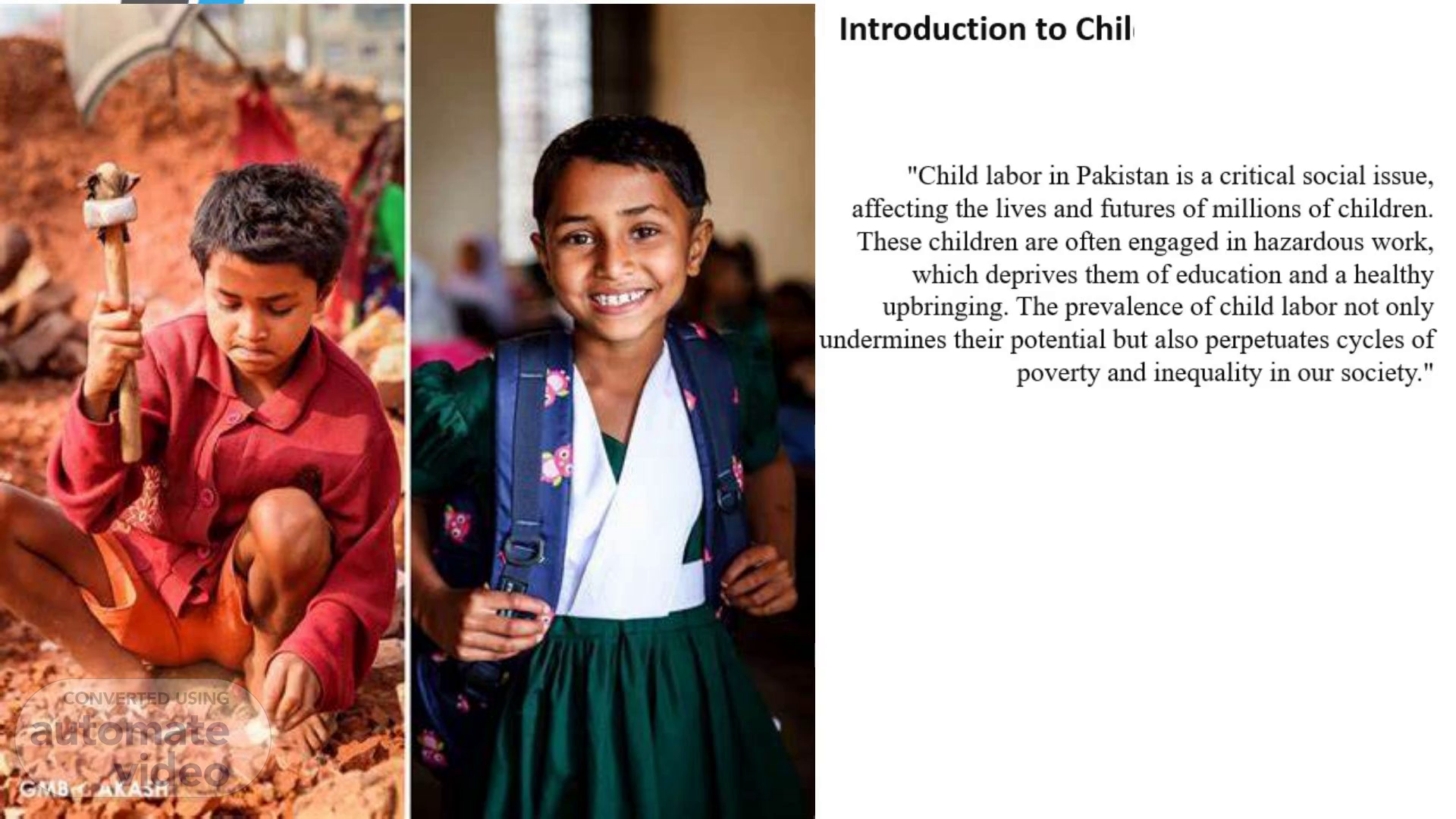
"Child labor in Pakistan is a critical social issue, affecting the lives and futures of millions of children. These children are often engaged in hazardous work, which deprives them of education and a healthy upbringing. The prevalence of child labor not
Scene 1 (0s)
"Child labor in Pakistan is a critical social issue, affecting the lives and futures of millions of children. These children are often engaged in hazardous work, which deprives them of education and a healthy upbringing. The prevalence of child labor not only undermines their potential but also perpetuates cycles of poverty and inequality in our society.".
Scene 2 (29s)
[image] Gavel In. "Policymakers have the power to enact and enforce laws that safeguard children from labor exploitation. Their decisions shape the legal and regulatory framework that can either curb or inadvertently encourage child labor practices.“ "Social leaders, including community heads, religious figures, and educators, are instrumental in raising awareness and driving grassroots action. They hold the key to changing societal norms and behaviours that perpetuate child labor.“ Influence in Policy and Legislation: "Shaping laws and policies for child protection." Driving Social Change and Awareness: "Mobilizing communities and altering public perceptions." Resource Allocation and Implementation: "Directing resources towards effective interventions and ensuring their proper execution.".
Scene 3 (1m 0s)
"As of 2021, an estimated 12.5 million children in Pakistan are engaged in child labor." "The majority of these children work in sectors such as agriculture, manufacturing, and services, with a significant portion involved in informal and domestic labor." "Demographically, children aged 5 to 14 years are most commonly involved, with a higher incidence among boys compared to girls." "Rural areas account for a higher prevalence of child labor compared to urban areas, with approximately 70% of child laborers coming from rural backgrounds.".
Scene 4 (1m 27s)
"Poverty: The primary driver of child labor in Pakistan is poverty. Families in impoverished conditions often rely on the income generated by their children to meet basic needs." "Lack of Education: Inadequate access to quality education compels many children to enter the workforce early. The absence of educational opportunities is both a cause and a consequence of child labor." "Socio-Economic Factors: Other factors include high unemployment rates among adults, cultural norms, lack of awareness about children's rights, and insufficient social protection mechanisms.".
Scene 5 (1m 52s)
[image] Pin on Educational Blog. "Health Risks: Child laborers are often exposed to hazardous conditions, leading to physical injuries, chronic illnesses, and psychological trauma. The lack of safety measures in informal sectors exacerbates these health risks." "Hindered Development: Engaging in labor at a young age can severely affect a child's emotional, cognitive, and social development. It deprives them of the education and socialization necessary for their overall growth." "Economic Consequences: While child labor provides short-term economic benefits for families, it perpetuates cycles of poverty. It also undermines national economic growth by maintaining a low-skilled workforce and discouraging investment in education.".
Scene 6 (2m 21s)
Diagrama Stakeholders. "Government: Responsible for creating and enforcing child labor laws, providing education and social services, and implementing policies that address the root causes of child labor." "NGOs: Play a crucial role in advocacy, raising awareness, providing education and rehabilitation services, and monitoring child labor practices." "Businesses: Can contribute by ensuring child-labor-free supply chains, practicing ethical labor standards, and investing in community development initiatives." "Communities: Essential in identifying and reporting child labor cases, promoting education, and changing cultural norms that perpetuate child labor.".
Scene 7 (2m 48s)
Current Laws: Briefly describe key existing laws and regulations in Pakistan that address child labor, such as the Employment of Children Act, the Bonded Labour System (Abolition) Act, etc." "Enforcement Challenges: Highlight issues related to the enforcement of these laws, such as lack of resources, corruption, or inadequate monitoring and reporting systems." "Legal Gaps: Identify areas where current legislation falls short, such as loopholes that allow certain forms of child labor, lack of comprehensive protection for all sectors, or insufficient penalties for violations.".
Scene 8 (3m 19s)
Case Study 1: The Punjab Education Sector Reform Program (Pakistan).
Scene 9 (3m 50s)
Actionable Strategies for Policymakers and Social Leaders.
Scene 10 (4m 22s)
45+ Hope Symbols With Meanings: The Complete Guide | TheMindFool.